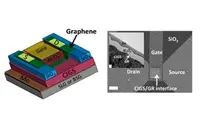 A group of scientists from at the US Department of Energy's (DOE) Brookhaven National Laboratory, Stony Brook University (SBU), and the Colleges of Nanoscale Science and Engineering at SUNY Polytechnic Institute claim to have developed a method for creating resilient, customised, and high-performing graphene: layering it on top of common glass. This scalable and inexpensive process is hoped to help pave the way for a new class of microelectronic and optoelectronic devices, from solar cells to touch screens.
A group of scientists from at the US Department of Energy's (DOE) Brookhaven National Laboratory, Stony Brook University (SBU), and the Colleges of Nanoscale Science and Engineering at SUNY Polytechnic Institute claim to have developed a method for creating resilient, customised, and high-performing graphene: layering it on top of common glass. This scalable and inexpensive process is hoped to help pave the way for a new class of microelectronic and optoelectronic devices, from solar cells to touch screens.
The team initially set out to optimise a solar cell containing graphene stacked on a high-performance copper indium gallium diselenide (CIGS) semiconductor, which in turn was stacked on an industrial soda-lime glass substrate.
Nanditha Dissanayake, formerly of Brookhaven Lab, said: "The sodium inside the soda-lime glass creates high electron density in the graphene, which is essential to many processes and has been challenging to achieve."
The scientists then conducted preliminary tests to provide a baseline for the effects of subsequent doping. But these tests showed that the graphene was already optimally doped without the introduction of any additional chemicals.
"To our surprise, the graphene and CIGS layers already formed a good solar cell junction," Dissanayake said. "After much investigation, and the later isolation of graphene on the glass, we discovered that the sodium in the substrate automatically created high electron density within our multi-layered graphene."
The scientists are now going to probe more deeply into the fundamentals of the doping mechanism and more carefully study the material's resilience during exposure to real-world operating conditions.
Matthew Eisaman, a physicist at Brookhaven Lab and professor at SBU, said: "Now that we have demonstrated the basic concept, we want to focus next on demonstrating fine control over the doping strength and spatial patterning."
They say that initial results suggest the glass-graphene method is much more resistant to degradation than many other doping techniques.
Graphene's high conductivity and transparency make it a promising candidate as a transparent, conductive electrode to replace the relatively brittle and expensive indium tin oxide (ITO) in applications such as solar cells, OLEDs, flat panel displays, and touch screens. In order to replace ITO, scalable and low-cost methods must be developed to control graphene's resistance to the flow of electrical current by controlling the doping strength.
"The potential applications for graphene touch many parts of everyone's daily life, from consumer electronics to energy technologies," Eisaman explained. "It's too early to tell exactly what impact our results will have, but this is an important step toward possibly making some of these applications truly affordable and scalable."
Author
Tom Austin-Morgan
Source: www.newelectronics.co.uk

